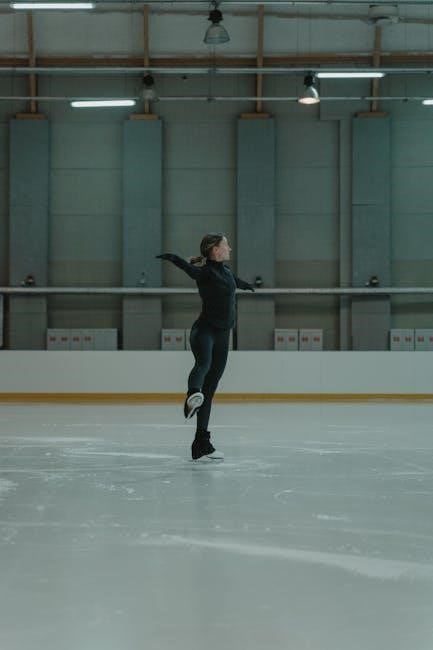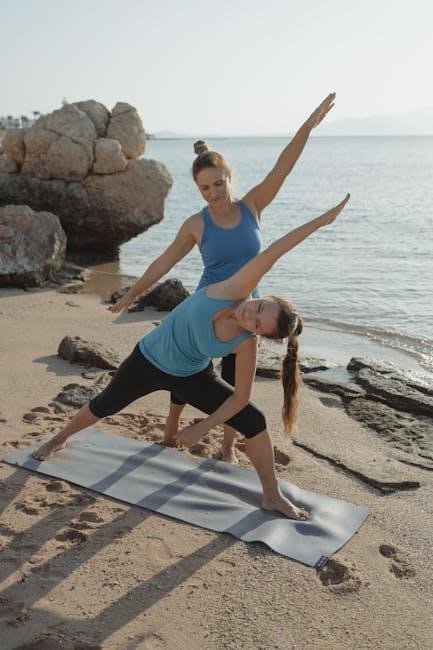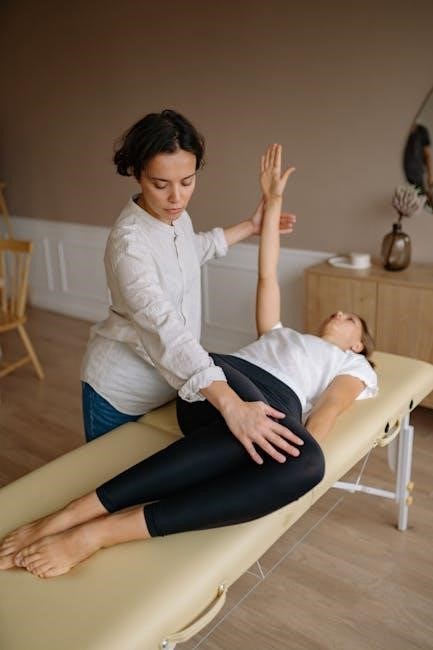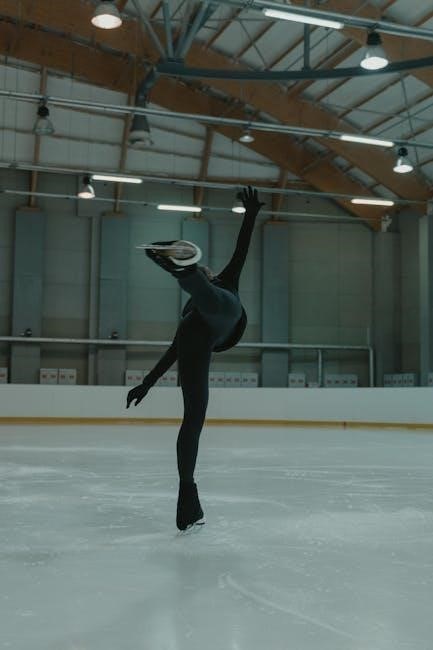Scoliosis is a spinal curvature condition that can impact posture, mobility, and overall well-being. Exercise plays a vital role in managing scoliosis, improving alignment, reducing pain, and enhancing spinal stability.
Understanding Scoliosis and Its Impact on the Spine
Scoliosis is a condition where the spine curves sideways, forming a C-shaped or S-shaped curve, and sometimes twists. This curvature can affect posture, mobility, and respiratory function if severe. Mild cases may not require treatment, but moderate to severe scoliosis can impact spinal alignment and overall health. The spine’s natural straight alignment is crucial for supporting the body and facilitating movement. Scoliosis disrupts this alignment, potentially leading to discomfort, reduced flexibility, and, in severe cases, complications like breathing difficulties. Understanding the extent and type of curvature is essential for developing targeted exercises to manage symptoms and improve spinal stability. Exercise plays a key role in addressing these challenges, focusing on strengthening muscles and enhancing flexibility without forcing the spine into an unnatural position.
The Role of Exercise in Managing Scoliosis
Exercise is a cornerstone in managing scoliosis, offering a non-invasive approach to improve spinal alignment, strength, and flexibility. Regular physical activity helps stabilize the spine, preventing curvature progression and enhancing posture. Tailored exercises can address specific areas affected by scoliosis, such as strengthening core muscles and improving balance. Additionally, exercise promotes overall physical well-being, reducing pain and discomfort. When combined with proper posture awareness, exercise can significantly improve the quality of life for individuals with scoliosis, providing long-term benefits without the need for more invasive treatments. A personalized exercise plan, designed with professional guidance, ensures safety and effectiveness in managing scoliosis symptoms and maintaining spinal health.

Best Exercises for Scoliosis
Effective exercises for scoliosis include cat-cow stretches, side planks, and bird-dog poses, which enhance spinal flexibility and core strength, promoting better posture and reduced discomfort.
Stretching Exercises for Flexibility and Alignment
Stretching exercises are essential for improving flexibility and promoting spinal alignment in individuals with scoliosis. The cat-cow stretch is highly recommended as it gently moves the spine through a range of motion, enhancing flexibility and reducing stiffness. The seated butterfly stretch targets the hips and lower back, helping to alleviate tightness and improve posture. Additionally, the hip flexor stretch can address imbalances in the pelvis, which are common in scoliosis. These exercises should be performed gently and within a comfortable range to avoid overstretching. Regular practice can help maintain spinal mobility and reduce discomfort. Always consider a personalized routine tailored to the specific curvature and needs of the individual;
Core-Strengthening Exercises for Improved Posture
Core-strengthening exercises are crucial for improving posture in individuals with scoliosis by stabilizing the spine and enhancing muscular support. Planks are highly effective for building core strength, as they engage the abdominal and back muscles, promoting spinal stability. The bird-dog exercise targets the deep core muscles, improving balance and posture. Pelvic tilts and bridges also help strengthen the lower back and pelvis, reducing curvature and improving alignment. These exercises should be performed with controlled movements to avoid strain. Strengthening the core can help reduce the progression of scoliosis and improve overall spinal health. Incorporating these exercises into a daily routine can lead to better posture and reduced discomfort over time.
Yoga Poses Specifically for Scoliosis
Yoga offers tailored poses to address scoliosis by enhancing spinal alignment and strength. The side plank is particularly effective, as it targets the muscles on the concave side of the curve, helping to reduce curvature. The cat-cow stretch improves flexibility and mobility in the spine, while the child’s pose provides gentle relief and promotes relaxation. The seated butterfly stretch and pigeon pose can help alleviate tightness in the hips and lower back, common in scoliosis. However, deep twists and forward folds should be avoided or modified to prevent worsening the curvature. Practicing these poses with a trained yoga therapist can help create a personalized routine to support spinal health and improve posture.

Scientific Approach to Scoliosis Exercises
The SEAS program combines active self-correction with targeted exercises to enhance spinal stability and alignment, offering a evidence-based method to manage scoliosis effectively.
The SEAS (Scientific Exercises Approach to Scoliosis) Program
The SEAS program is a comprehensive approach designed to address scoliosis through specific exercises tailored to each patient’s condition. It emphasizes active self-correction techniques combined with exercises that challenge spinal stability and alignment. The program is based on scientific evidence and aims to halt the progression of spinal curvature, reduce pain, and improve posture. SEAS incorporates balance and alignment-focused exercises, helping patients develop reflexive responses to maintain a straighter spine. This method is particularly effective for individuals with moderate scoliosis and is often recommended as a first-line treatment to avoid more invasive options like bracing or surgery. Regular practice of SEAS exercises can lead to significant improvements in spinal health and overall well-being.

Age-Specific Recommendations
- Children and teens: Focus on core-strengthening and flexibility exercises to support spinal growth and alignment.
- Adults: Prioritize exercises that strengthen back muscles and improve posture to manage scoliosis effectively.
Exercises for Children and Teenagers
Exercises for children and teenagers with scoliosis focus on improving core stability, flexibility, and spinal alignment. Activities like the cat-cow stretch, bird-dog, and side plank are effective for strengthening muscles and promoting proper posture. For younger children, fun, dynamic exercises such as swimming or balance games can help build strength without feeling like a chore. Teenagers can benefit from more structured routines, including the Scientific Exercises Approach to Scoliosis (SEAS) program, which combines self-correction techniques with targeted exercises. It’s important to tailor exercises to the child’s age, abilities, and specific scoliosis presentation to ensure safety and effectiveness. Regular physical activity can help manage scoliosis progression and improve overall spinal health during growth and development.
Exercises for Adults with Scoliosis
Adults with scoliosis benefit from exercises that strengthen back muscles, improve posture, and enhance flexibility. Low-impact activities like yoga and swimming are ideal, as they minimize stress on the spine. Strengthening exercises such as planks, bridges, and pelvic tilts can help stabilize the core and reduce pain. Gentle stretches, including the seated butterfly and hip flexor stretches, improve range of motion. Yoga poses, such as the child’s pose and cobra pose, can also provide relief. It’s essential to avoid high-impact exercises that may worsen the condition. A consistent routine, tailored to individual needs, can help manage symptoms and improve spinal health, ensuring long-term mobility and comfort for adults with scoliosis.

Safety and Precautions
When performing scoliosis exercises, avoid high-impact activities, consult a healthcare provider before starting any routine, and tailor exercises to individual spinal conditions and pain levels.
Understanding Safe Exercises for Scoliosis
Safe exercises for scoliosis focus on improving spinal alignment, strength, and flexibility without exacerbating the curvature. It’s crucial to consult a healthcare provider or physical therapist to tailor routines to individual needs. Low-impact activities, such as yoga and swimming, are often recommended, while high-impact sports may be avoided. Core-strengthening exercises, like planks and bridges, help stabilize the spine. Stretching, such as cat-cow or seated butterfly stretches, can enhance flexibility. Avoiding heavy lifting and twisting movements is essential. The Scientific Exercises Approach to Scoliosis (SEAS) program is a structured method that emphasizes active self-correction. Proper posture and alignment should always be prioritized to maximize benefits and minimize risks.
Effective scoliosis exercises, when performed consistently, can significantly improve spinal alignment, reduce pain, and enhance overall well-being, making them a vital part of managing the condition.
Effective scoliosis exercises focus on improving spinal alignment, strength, and flexibility. Stretching exercises like side planks and cat-cow stretches can enhance mobility, while core-strengthening activities, such as bird-dog and pelvic tilts, support posture. Yoga poses, including child’s pose and seated twists, are beneficial when tailored to individual needs. The SEAS program combines self-correction with stability exercises to address curvature. For children and teens, age-specific core exercises are recommended, while adults benefit from low-impact activities like swimming. Avoiding high-impact sports and heavy lifting is crucial. Consistency and professional guidance are key to maximizing benefits and preventing progression. Regular exercise can significantly improve quality of life for those with scoliosis.

Leave a Reply
You must be logged in to post a comment.